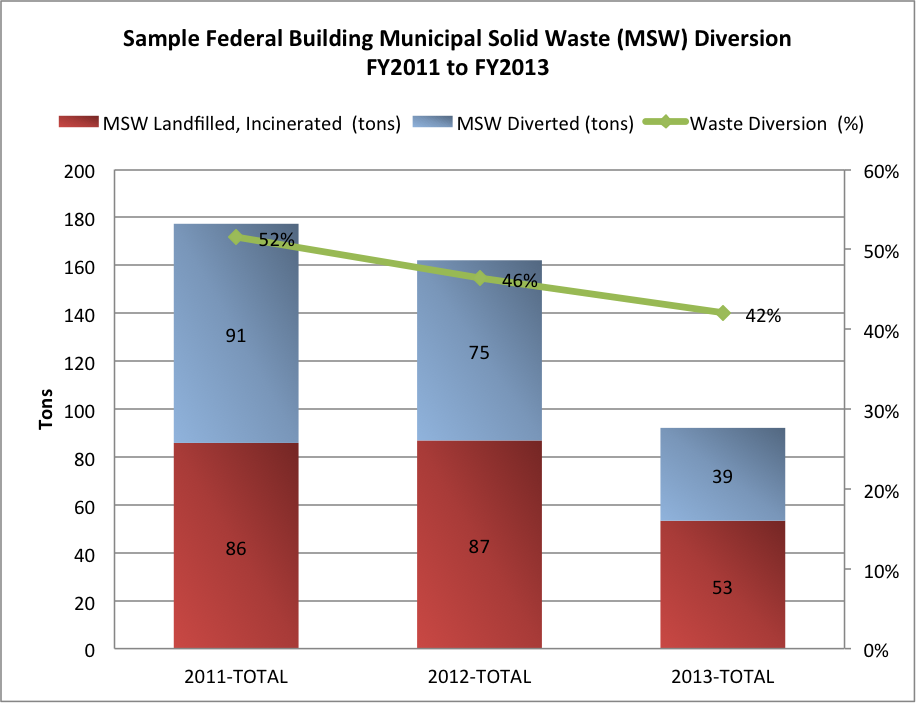On average, 70% (by weight) of the total municipal solid waste, generated in a federal office building, can either be recycled or composted. The majority of the waste stream is comprised of paper, food waste, and other organic waste. To maximize material recovery and avoid waste disposal to landfills, the O&M team should take steps to implement a sustainable waste management program. Keep in mind that solid waste regulations and markets vary by state and municipality, as well as by waste material type and quantity.
A recommended approach to developing and managing a cost-effective, sustainable waste management program is to:
- Form a multi-disciplinary team to review the current waste disposal service needs and requirements. Key players in the team include the Property Manager, custodial service provider, and tenant representatives.
- Develop a Waste Management Policy and Waste Management Project Plan, and establish waste diversion goals. Conduct a solid waste audit, which provides quantities and types of waste generated at a building. For buildings with cafeterias, conduct a food waste assessment to determine the amount of food waste generated in the cafeteria. The solid waste audit and food waste assessment can be completed by property management personnel, the waste management service provider, or third party consultants.
- Review waste audit and food waste assessment results. Conduct a cost-benefit analysis to identify savings from increased recycling and reduced trash to the landfill.
- Review existing service contracts and conduct research to find certified recyclers for waste materials that are not already recycled in the building. For example, determine whether a licensed commercial food waste composting facility and food waste haulers are available to pick up food waste on a weekly schedule.
- Design and implement a recycling system that meets building occupant needs and that maximizes the amount of waste that is recycled, without necessarily increasing custodial labor.
- Create a Communication Plan and maintain consistent and frequent marketing of the recycling program, including consistent waste collection bin design, color-coding, and signage.
- Monitor waste diversion performance and savings from avoided landfill disposal, to continually improve the waste management program. The graph below shows an example of a building’s solid waste diversion performance, from year to year. The waste diversion is calculated using this formula:
Solid Waste Diversion(%) =
(Weight (tons) of solid waste recycled, composted,reused,and donated/sold )
(Weight (tons)of solid waste landfilled,incinerated, recycled,composted,reused,and donated/sold)
× 100
The graph shows that the waste diversion is decreasing, from 52% in 2011, to 42% in 2013. This means that a larger percentage of the building’s total waste stream is being landfilled rather than recycled. Even though the waste diversion percentage has declined, the building’s waste management program has decreased the total amount of waste generated from 177 tons in 2011, to 92 tons in 2013—a 48% reduction in waste in two years. This latter indicator is a sign of an effective program, assuming that the building population has remained the same.

Through a Green Construction Policy and Waste Management Plan, a project team can effectively plan for and take steps to minimize the amount of non-hazardous construction and demolition waste disposed in landfills. Establish a minimum waste diversion rate for all construction waste, based on municipal requirements or federal sustainability goals.
In the planning stage and in solicitations for offers (SFOs), require the contractor to provide a Waste Management Plan that:
- Explains how building materials will be reused, salvaged, or recycled, to avoid landfill disposal.
- Lists proposed materials to be reused or recycled. Reuse and/or recycling typically includes: corrugated cardboard, metals, concrete brick, asphalt, clean dimensional lumber, plastic, glass, metal studs, and flooring materials (such as carpet) if applicable to the project.
- Identifies local recycling and salvage operations that could process site-related construction and demolition materials. During construction, recycle or salvage at least 50% of the non-hazardous construction, demolition, and land-clearing materials (excluding soils), where recycling markets or onsite reuse opportunities exist.
- Lists materials that cannot be recycled or reused with an explanation or justification.
- Provides frequency of meetings to address waste management (with subcontractors).
- Explains collection, handling, storage, and transport methods of waste and recyclables, including means of keeping recyclables free of contamination to maximize recovery.
- Describes a quality control program to ensure that waste does not leave the project building through uncontrolled or unmonitored channels.
- Reporting of waste diversion rates. Require the contractor to record and track the type and quantity, by weight or volume, of each type of material salvaged, reused, recycled, or disposed.


